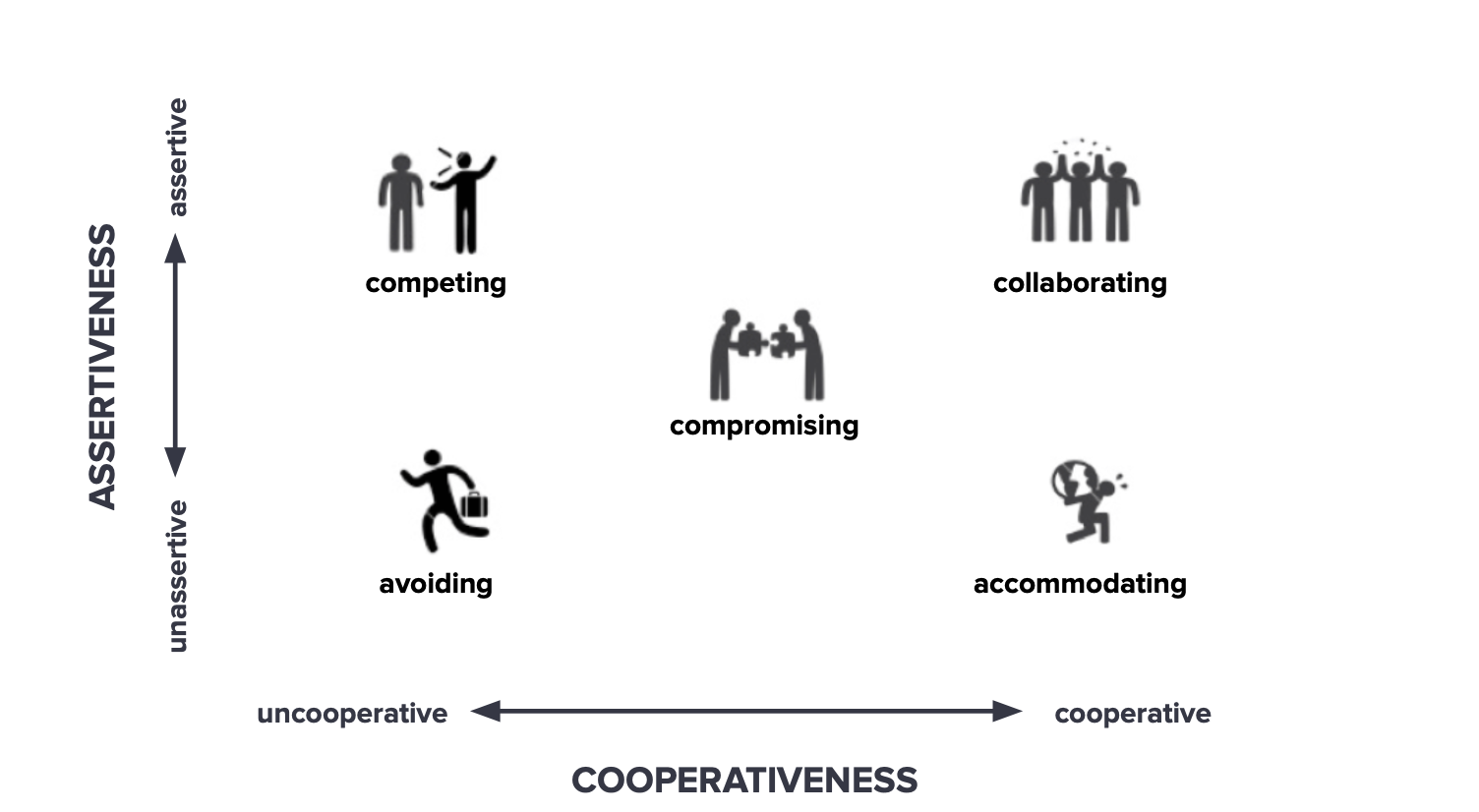Learning about conflict styles
17 May 2019In 2018 I took a course on conflict transformation, I wrote about why and how here. This second post explores ‘conflict styles’ and how we use different styles of conflict in different contexts. It’s a long-format post so grab a hot beverage and get comfy.
Ever clam up when you see friends or colleagues get into a disagreement? Or maybe you jump head first into an exciting debate about emacs vs vim? Perhaps you’re the one your team who pulls the group together to find consensus.
All of these scenarios are examples of different styles of conflict.
Styles of conflict
In the 1970s psychologists Kenneth Thomas and Ralph Kilmann developed a model to better understand the different styles we use to respond to conflict. They classified five main conflict styles: competing, avoiding, collaborating, accommodating, and compromising. Thomas and Kilman mapped these conflict styles on to a chart based on two axes (“assertiveness” and “cooperativeness”):

Our lived experiences and culture impacts how we use or avoid different conflict styles. For the most part we gravitate towards a particular style but typically use all five depending on the context.
We also react differently to other people’s use of conflict styles and can feel uncomfortable when confronted with a style we don’t like (even though we may use it ourselves).
Let’s delve a bit further into each.
Competing: “my way”
We often use this style when we are convinced of our rightness and are unwilling to cooperate to find a middle ground. The style is usually associated with stubbornness, assertiveness, even aggression.
However, its bad reputation is not always deserved.
Folks who gravitate towards this style sometimes enjoy the thrill of debate. Moreover, what comes across as assertiveness or aggression can feel like confidence to the person using this style.
It’s also necessary in an emergency – taking control of a situation and dictating direction helps guide a group.
Avoiding: “no way”
For many this will be an all too familiar feeling: that cringing discomfort when a friendly conversation turns to a sour debate. It might not even be a tense debate, it could be any flicker of conflict and we’re already out the door.
If we gravitate towards this conflict style it means we will avoid conflict at all cost, even if it means discomfort for ourselves.
In the long term it can be detrimental to our mental health and sense of self if we always avoid conflict.
Accommodating: “your way”
To me this style is similar to avoiding conflict but there’s a subtle difference. Avoiding conflict means we refuse to even engage with conflict.
In contrast, the accommodating style means although we don’t assert our position, we do engage with the person we’re in conflict with by prioritising cooperation.
In the long term this style can be emotionally corrosive. We fail to assert ourselves to the detriment of our mental health.
Yet sometimes accommodating is a sensible approach, especially if the issue is insignificant. Why sweat the small stuff?
Collaborating: “our way”
Perhaps this is the most idealised style. It sounds great, right? We get together to decide something which works for everyone.
Yet on the Thomas-Kilmann chart it sits in an odd place: the most cooperative and most assertive.
Why most assertive? Because the collaborative style means each individual asserts their perspective without bending but must agree as a group.
There is a downside: this style takes time, lots of time. Everyone has to agree with each other and ensure that each person gets what they want.
Compromising: “halfway”
From my experience this can be the hardest but most rewarding conflict style.
It’s a mix of cooperation and assertiveness.
We achieve a balance of give and take with the person we’re in conflict with –– giving up a little of our position as they give up a little of theirs.
Conflict Transformation encourages us to step back, reflect on each of these styles, and understand we can choose how we respond to conflict.
In the next post I’ll talk about how to use different styles in different contexts. Stay tuned.
Note: You can find out your conflict style profile by taking a survey developed by the United States Institute of Peace.